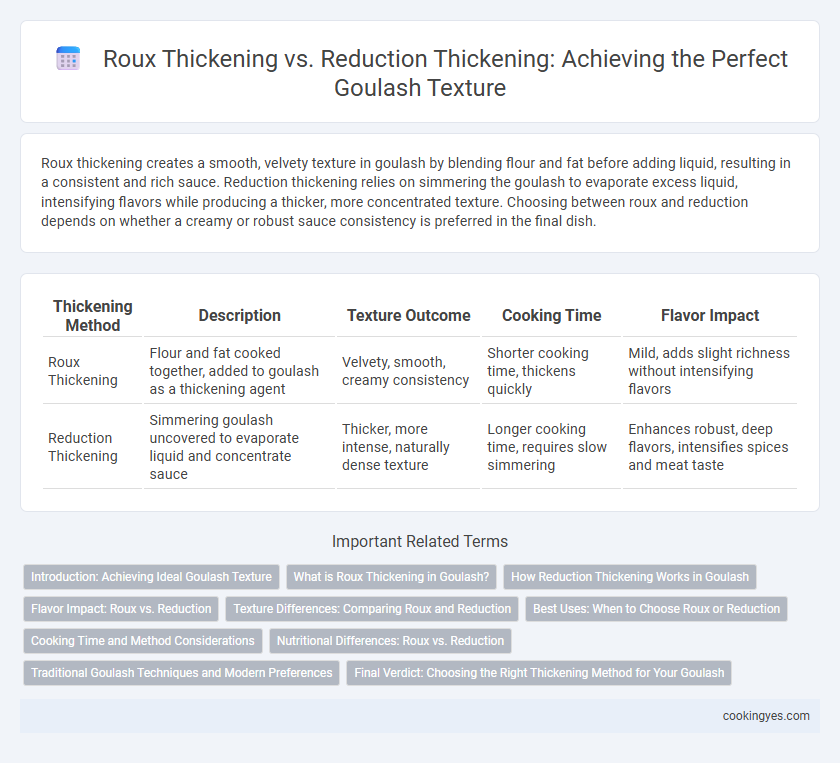Roux thickening creates a smooth, velvety texture in goulash by blending flour and fat before adding liquid, resulting in a consistent and rich sauce. Reduction thickening relies on simmering the goulash to evaporate excess liquid, intensifying flavors while producing a thicker, more concentrated texture. Choosing between roux and reduction depends on whether a creamy or robust sauce consistency is preferred in the final dish.
Table of Comparison
| Thickening Method | Description | Texture Outcome | Cooking Time | Flavor Impact |
|---|---|---|---|---|
| Roux Thickening | Flour and fat cooked together, added to goulash as a thickening agent | Velvety, smooth, creamy consistency | Shorter cooking time, thickens quickly | Mild, adds slight richness without intensifying flavors |
| Reduction Thickening | Simmering goulash uncovered to evaporate liquid and concentrate sauce | Thicker, more intense, naturally dense texture | Longer cooking time, requires slow simmering | Enhances robust, deep flavors, intensifies spices and meat taste |
Introduction: Achieving Ideal Goulash Texture
Roux thickening creates a rich, velvety texture in goulash by blending equal parts flour and fat cooked together, providing a smooth, consistent base. Reduction thickening intensifies flavor while naturally thickening the stew as water evaporates during slow simmering, resulting in a more robust, concentrated texture. Combining roux and reduction techniques balances smoothness with depth, achieving the ideal goulash consistency favored in traditional Hungarian cuisine.
What is Roux Thickening in Goulash?
Roux thickening in goulash involves cooking equal parts fat and flour to create a paste that is added to the stew, resulting in a smooth, velvety texture. This method enhances the goulash's body without reducing the liquid, preserving the rich, robust flavors. Unlike reduction thickening, roux thickening provides consistent thickness and a creamy mouthfeel essential for traditional Hungarian goulash.
How Reduction Thickening Works in Goulash
Reduction thickening in goulash works by simmering the stew gently over low heat, allowing water to evaporate and concentrate the flavors, which naturally thickens the sauce without additional thickeners. This process enhances the rich, robust texture as the meat and vegetables release gelatin and starches during cooking, contributing to a velvety mouthfeel. Unlike roux thickening, which relies on flour and fat, reduction thickening maintains the authentic depth of traditional goulash while intensifying its savory taste.
Flavor Impact: Roux vs. Reduction
Roux thickening in goulash creates a smooth, velvety texture by incorporating browned flour and fat, which also imparts a subtle nutty flavor enhancing the dish's richness. Reduction thickening concentrates flavors by simmering liquid over time, intensifying the meat and spices but can result in a denser, less creamy texture. Choosing roux emphasizes a balanced, creamy mouthfeel with gentle flavor development, while reduction intensifies robust, concentrated flavors with a more rustic consistency.
Texture Differences: Comparing Roux and Reduction
Roux thickening creates a smooth, velvety texture in goulash by coating the ingredients with a flour and fat mixture, resulting in a rich and creamy consistency. Reduction thickening intensifies flavors by simmering the liquid to evaporate water, producing a thicker, more concentrated sauce with a slightly coarser texture. The roux method offers a silkier finish, while reduction emphasizes a robust, hearty body in the stew.
Best Uses: When to Choose Roux or Reduction
Roux thickening in goulash provides a rich, velvety texture ideal for stews that require a creamy, consistent body, especially when using flour-based thickening. Reduction thickening concentrates flavors and intensifies the sauce, perfect for slow-cooked goulash where a robust, slightly thicker but less creamy consistency is desired. Choosing roux suits recipes needing immediate thickening, while reduction benefits dishes that cook longer, allowing flavors to meld and deepen naturally.
Cooking Time and Method Considerations
Roux thickening in goulash requires precise timing to cook the flour evenly, creating a smooth and velvety texture without graininess, typically achieved early in the cooking process. Reduction thickening relies on prolonged simmering to evaporate excess liquid, concentrating flavors while naturally thickening the sauce, which extends cooking time but enhances depth. Choosing between roux and reduction impacts the cooking method: roux necessitates initial preparation before adding liquids, whereas reduction demands steady heat and patience to achieve the desired consistency.
Nutritional Differences: Roux vs. Reduction
Roux thickening in goulash adds calories and fat due to the flour and fat base, impacting the dish's overall nutritional profile with increased carbohydrates and lipids. Reduction thickening, achieved by simmering the stew to evaporate liquid, concentrates flavors and nutrients without adding extra calories or fat. Choosing reduction allows for a lower-calorie, nutrient-dense goulash with a richer taste, while roux imparts a creamier texture but increases caloric content.
Traditional Goulash Techniques and Modern Preferences
Traditional goulash often relies on roux thickening, where flour and fat are cooked before adding liquids to create a rich, velvety texture that binds the stew. Modern preferences tend to favor reduction thickening, simmering the stew slowly to concentrate flavors and naturally thicken the sauce without added starch. Both techniques impact the final texture: roux provides a creamy consistency, while reduction enhances the depth and intensity of the goulash's hearty character.
Final Verdict: Choosing the Right Thickening Method for Your Goulash
Roux thickening creates a creamy, velvety texture by blending flour and fat, ideal for a smooth, rich goulash sauce, while reduction thickening intensifies flavors and concentrates the sauce by simmering it down. Selecting roux is best when a consistent, thicker base is desired, whereas reduction suits those seeking a robust, intensified taste with a more pronounced tomato or paprika flavor. The final choice depends on whether texture smoothness or flavor concentration is the primary goal in your goulash preparation.
Roux thickening vs reduction thickening for goulash texture Infographic

 cookingyes.com
cookingyes.com